Polar research: Warming in the cooler
10 Jun 2024
The Antarctic is a key region for the global climate – and here, too, the greenhouse effect is leaving its mark. From the research magazine EINSICHTEN
10 Jun 2024
The Antarctic is a key region for the global climate – and here, too, the greenhouse effect is leaving its mark. From the research magazine EINSICHTEN

Read more about highlights of research in the current issue of our LMU magazine EINSICHTEN at www.lmu.de/einsichten. | © LMU
Huge fields of sea ice, kilometer-thick ice sheets, and enormous glaciers: A few weeks after returning from Antarctica, Gonzalo Gomez-Saez is still overwhelmed. “You’re really alone there, in the middle of nowhere, surrounded by untouched beauty,” raves the Biogeochemist. Far away from civilization, humans are just guests in that extreme environment. But as remote as this world seems, far-reaching changes are taking place: The dramatic shrinking of sea ice, rising temperatures, and disappearing glaciers attest to the impact of climate change even here. How microbial communities respond to temperature changes, is one of the questions that Gomez-Saez investigates.
Meanwhile, Alexander Haumann, Professor of Physical Geography with Focus on Oceanography at the Department of Geography, mostly studies the physical world: “Many people probably don’t realize that the Southern Ocean stores vast amounts of anthropogenic CO2 and heat,” says Haumann. “The ocean as a whole absorbs around 90 percent of the heat that is additionally absorbed by the climate system through fossil emissions. Three-quarters of this amount end up in the Southern Ocean. And it’s a similar story with carbon dioxide. Also there a relatively large share is taken up by the Southern Ocean.” As such, the Southern Ocean has been one of the most important brakes on global warming.
Of course, changes in the Southern Ocean don’t influence our weather of tomorrow, but in the long term the influence on our local climate and the people in Europe is massive.Alexander Haumann
As the planet’s “cooler,” the Antarctic powers winds and ocean currents. Consequently, it also drives global cycles such as heat and carbon cycles. But what happens if climate change alters ocean circulation and the properties of the Southern Ocean? That is one of the questions that Haumann seeks to answer. In contrast to the tropics and subtropics, where the temperature differences between warm surface water and cold deep water create such robust stratification that hardly any exchange takes place, the water layers mix more easily in the cold Antarctic. “Around 80 percent of global deep water masses from the Pacific and Atlantic only resurface in the Southern Ocean,” says Haumann. Because the deep ocean contains about 40 times more carbon dioxide than the atmosphere, there is a natural release of CO2 in the polar regions when deep waters return to the surface, whereas CO2 is absorbed by the ocean in other regions. If the circulation and mixing of water layers change, this can alter the balance of these and many other processes in turn.
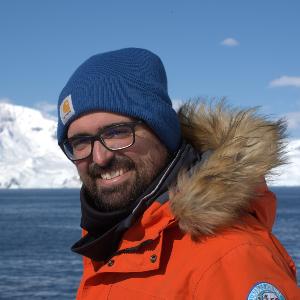
Gonzalo Gomez-Saez | © David Velazquez
The influence of biological processes on the carbon stored in the oceans is a subject being investigated by Gonzalo Gomez-Saez, leader of an interdisciplinary Emmy Noether research group at LMU’s Department of Earth and Environmental Sciences. A sizable portion of organic carbon is contained in dissolved organic material, which radiocarbon analyses indicate has been accumulating in the ocean for over 6,000 years in some cases.
Why these substances are not metabolized remains a puzzle to marine scientists. In the Antarctic, as visiting scientists on the Lindblad Expeditions-National Geographic 'Journey to Antarctica' voyage (funded from LEX-NG funds), Gomez-Saez and his Spanish colleague David Velázquez, National Geographic Explorer from Universidad Autónoma de Madrid collected water, ice, and soil samples. “It was especially challenging to conserve our samples without the microbes growing or incurring cell damage,” recalls Gomez-Saez. “But I am confident we will obtain some novel and exciting results on the interplay between microbes and dissolved organic matter in this vulnerable ecosystem.”
You’re really alone there, in the middle of nowhere, surrounded by untouched beauty.Gonzalo Gomez-Saez
Currently, the samples are still being stored at minus 20 degrees in the town of Ushuaia in Tierra del Fuego. As soon as they arrive at his laboratory in Munich, Gomez-Saez will investigate the ability of the microbes to process various kinds of dissolved organic substances. To this end, he will use carbon compounds labeled with stable isotopes to track their development and undertake genetic studies to analyze which microbes are active when. “Colder temperatures could lead to higher carbon contents,” explains Gomez-Saez. Through his experiments, he wants to ascertain, among other things, what influence temperature has on microbial activity and whether certain forms of dissolved organic matter are more enticing for microbes than others.
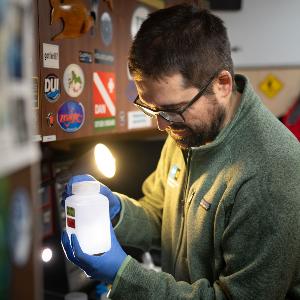
Gonzalo Gomez-Saez examines the freshly collected samples on board the ship. | © David Wright & Elizabeth Elliott
Which molecules make up the dissolved organic material in his samples? Where do they come from? How are they metabolized? Gomez-Saez investigates these questions in cooperation with research groups at the GeoBio-Center of LMU, at the Max Planck Institute in Bremen and at the University of Oldenburg. This is where one of the most powerful mass spectrometers in Germany is located, capable of determining the mass of thousands of molecules simultaneously with extremely high precision.
Gomez-Saez hopes his results will help bring about a better understanding of the effects of climate change on ocean ecosystems. “The rise in temperature predicted for the coming decades will impose new conditions on all living creatures on the planet. The Antarctic could be a very sensitive and valuable early warning system for understanding global warming,” says Gomez-Saez, who also researches another effect of climate change in the ocean with his group, one that chiefly affects the mid-latitudes: the enlargement of ocean zones lacking in oxygen. As with the exchange of CO2 between ocean and atmosphere, the stratification of water masses also plays a role here, as it can prevent water circulation and therefore ventilation.
The Antarctic could be a very sensitive and valuable early warning system for understanding global warming.Gonzalo Gomez-Saez
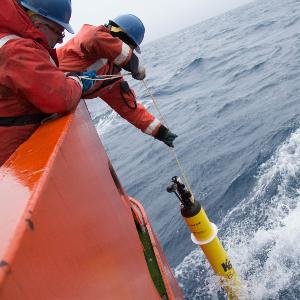
An Argo float is lowered into the water. | © Isa Rosso, SOCCOM Project, Princeton University
New measurements indicate that the natural cycle of the Southern Ocean probably releases more CO2 than previously assumed. As Haumann explains, however, it is currently difficult to say how much CO2 actually comes from the ocean, and whether this is influenced by climate change. These uncertainties are bound up with the difficulties climate models currently have in correctly representing the system in the Southern Ocean – partly owing to the dearth of measurements from this region.
“The Antarctic region is unlike many other regions on Earth, and many of the global models were developed with data from other regions,” says Haumann. In a new project, for which – in collaboration with the Alfred Wegener Institute and LMU – he received a Starting Grant from the European Research Council (ERC) and a Helmholtz Young Investigator Group, the climate scientist plans to collect new insights to improve climate models in this region. One of the goals of the project is to better understand the exchange between surface and deep water in the Southern Ocean and assess its effect on changes in the global climate.
Many people probably don’t realize that the Southern Ocean stores such vast amounts of anthropogenic CO2 and heat.Alexander Haumann
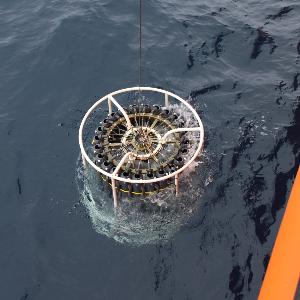
A standard oceanographic device: the CTD rosette | © Alexander Haumann
Much of his data comes from so-called Argo floats: Some 3,500 of these automated floats currently drift with the ocean currents, sink every ten days to a depth of up to 2,000 meters, and then rise again to the surface. During the entire time, they assiduously measure temperature, salinity, and pressure. Further sensors can also be fitted to measure things like the pH value and nitrate concentration. “This data is very helpful, as the floats even survive under the ice and continue to record data there. When spring comes around, it’s always exciting to see if they come back.”
A standard measuring instrument that is used in oceanography frequently and for many decades is the so called CTD rosette: a cylindrical metal frame, which the researchers fit with numerous sensors. In addition, bottles are attached around the frame to collect water samples at various depths – high-tech messages in a bottle, as it were. This way, the Alfred Wegener Institute collected important measurement time series in the Southern Ocean for many decades. They are critical for Haumann and his team to better understand the long-term climatic changes and the associated changes in the heat, carbon, and water cycle of this region.
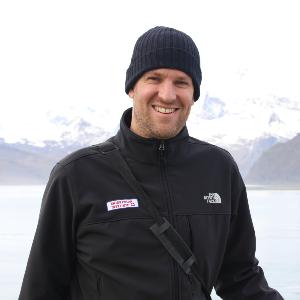
Alexander Haumann | © Alexander Haumann
Current results from Haumann’s research concern the dramatic disappearance of sea ice, which reached record levels in 2023. Unlike in the Arctic, almost the entire sea ice in the Antarctic forms every year, when the uppermost layer of the ocean freezes in winter. Most of the ice is produced in the coastal regions of the Ross Sea and the Weddell Sea, sometimes dubbed “ice factories of Antarctica”. Up until 2015, these areas of ice actually expanded, to the surprise of many scientists. “The cause was presumably stronger winds, which carried the sea ice further out from the ice factories. This created an open area of ocean that could then freeze again,” explains Haumann. “But from 2015, the system suddenly tipped.” Within two years, some four million square kilometers of ice disappeared – a trend that has continued to this day after a brief interlude of recovery.
“The big question is whether this is a natural process or should be interpreted as a climate change signal,” says Haumann. According to his results, several factors are converging. Firstly, there are natural decadal fluctuations of salinity, which determines the stability of the water column stratification in the Southern Ocean. In the polar regions, cold water lies on top of warmer water. They would actually mix, as cold water is denser than warmer water and should sink. “But that doesn’t happen because the water above is generally less salty than the water below,” explains Haumann. If this distribution changes, the stratification can become unstable and more heat can reach the surface, causing more ice to melt. Early satellite images from the 1970s show that the sea ice also vanished back then, which the climate scientist attributes to this effect.
The big question is whether this is a natural process or should be interpreted as a climate change signal.Alexander Haumann
Today, however, the menace is coming from the deep: Compared to the 1970s, the deep waters bring considerably more heat close to the surface. “We’re seeing that the water at a depth of 150 meters has warmed up a lot,” explains Haumann. “If the stratification now becomes more unstable due to a higher salinity – and that is what is currently happening – then this warm water entrains into the surface layer more easily.” As part of the global overturning circulation – a gigantic water conveyor belt that connects the Atlantic, Pacific, and Indian Oceans with the Southern Ocean – water flows from the tropics and subtropics toward the South Pole. Scientists expect that more and more heat will reach Antarctica in this way due to global warming.
Oceanographers have been observing for years how glaciers, which of course extend deep into the water, are melting from below. “But the sea ice at the surface was shielded for a long time by low salinities in the upper 100 meters,” notes Haumann. But now the consequences of warming are becoming visible here, too, and Haumann thinks it is possible that a tipping point is being reached through a combination of global warming and decadal fluctuations. If the sea ice cover remains smaller in the long term, there would be consequences for numerous organisms that critically depend on this environment. Moreover, with less sea ice more heat could get into the ocean, which would further impede ice formation and disrupt the ocean circulation – a vicious cycle. “There are indicators that point to a tipping of the system,” says Haumann. However, the question remains open as to whether the tipping point is natural or related to climate change, as such tipping points have probably also occurred in the past – in connection with ice ages, for instance.
The rise in temperature predicted for the coming decades will impose new conditions on all living creatures on the planet.Gonzalo Gomez-Saez
Whether these effects can reverse again remains unclear. Ice and ocean mutually affect each other and there are many feedback effects that are not yet well understood. What is certain is that the polar regions are particularly susceptible to climate change. Through the study of ocean dynamics, water properties, and biological processes, Haumann and Gomez-Saez are investigating different facets of this complex system and contributing to our understanding of the changes that will shape the future of the planet. “People always think it’s so far away,” observes Haumann. “Of course, changes in the Southern Ocean don’t influence our weather of tomorrow, but in the long term the influence on our local climate and the people in Europe is massive.”
Dr. Gonzalo Gomez-Saez heads an Emmy Noether Group at LMU’s Department of Earth and Environmental Sciences, Palaeontology and Geobiology. He studied in Spain, Sweden and Finland and did his doctorate at the University of Bremen. Subsequently, he worked as a postdoc at the MARUM Center for Marine Environmental Sciences and the Max Planck Institute for Marine Microbiology, both in Bremen, as well as at the Institute for Chemistry and Biology of the Marine Environment at the University of Oldenburg and at the Alfred Wegener Institute.
Prof. Alexander Haumann is currently Interim Professor of Physical Geography with Focus on Oceanography at LMU’s Department of Geography. He studied geosciences with a major in geography at the University of Basel and meteorology, physical oceanography, and climate at Utrecht University. Having completed his doctorate at ETH Zurich, he researched at Princeton University and the British Antarctic Survey for four years. Since 2023, he has been a research group leader at the Alfred Wegener Institute and LMU.
Read more articles from "EINSICHTEN. Das Forschungsmagazin" in the online section and never miss an issue by activating the e-paper alert.
Or subscribe to the free print version of EINSICHTEN.